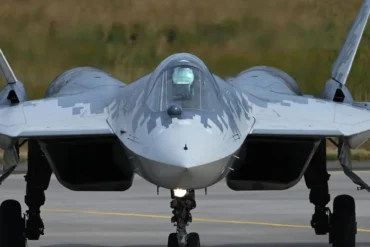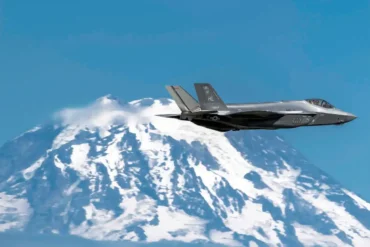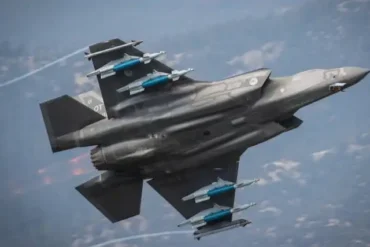Eurofighter Vs. F-35: Amidst the Cold War tensions, European nations sought to counter the persistent threat posed by the Soviet Union. Concurrently, the United States aimed to replace its aging aircraft over the Pacific with a versatile multi-role solution. The Eurofighter and the F-35 emerged as ideal candidates.
These aircraft exhibit distinctions that warrant exploration. This blog will delve into the factors that set the Eurofighter apart from the F-35, and vice versa.
Notably, there is no significant price discrepancy, with the difference falling below 5%. The Eurofighter’s dual engine necessitates more intricate maintenance, while the F-35 proves more cost-effective. In Beyond Visual Range (BVR) scenarios, the Joint Strike Fighter (JSF) holds a substantial advantage. With superior stealth characteristics, the JSF remains undetectable by radar, contrasting the Eurofighter, which relies solely on frontal radar avoidance. The Eurofighter’s enhanced agility positions it as a formidable force in dogfights.
Eurofighter Typhoon vs F-35 Lightning II Comparison
The Eurofighter Typhoon and the F-35 Lightning II stand as contemporary multi-role fighter aircraft crafted for distinct purposes by different nations. Below is an in-depth comparison of these two fighters:
Development and Origins:
Eurofighter Typhoon:
- Developed by a consortium comprising European nations such as the United Kingdom, Germany, Italy, and Spain.
- Maiden flight in 1994, entering service in the early 2000s.
F-35 Lightning II:
- Developed by a consortium led by the United States, with contributions from various partner nations.
- Three primary variants: F-35A (conventional takeoff and landing), F-35B (short takeoff and vertical landing), and F-35C (carrier-based).
- Inaugural flight in 2006, with distinct variants entering service in subsequent years.
Role and Mission:
Eurofighter Typhoon:
- Primarily excelling as an air superiority fighter, it has evolved into a versatile multi-role platform.
- Demonstrates proficiency in both air-to-air and air-to-ground missions.
F-35 Lightning II:
- Crafted as a multi-role stealth fighter, emphasizing ground-attack and reconnaissance capabilities.
- Exhibits prowess in air-to-air combat, air-to-ground strikes, electronic warfare, and intelligence, surveillance, and reconnaissance (ISR).
Stealth and Design:
Eurofighter Typhoon:
- Embraces a non-stealthy design, relying on agility and advanced radar systems for survivability.
F-35 Lightning II:
- Integrates stealth technology to diminish radar cross-section and elevate survivability.
- Features a low observable design to minimize visibility to radar.
Avionics and Sensors:
Eurofighter Typhoon:
- Incorporating the CAPTOR-M mechanically scanned radar for enhanced capabilities.
- Boasts an advanced avionics and sensor suite, including infrared search and track (IRST) capabilities.
F-35 Lightning II:
- Showcasing the AN/APG-81 AESA radar, delivering advanced air-to-air and air-to-ground capabilities.
- Utilizes the Distributed Aperture System (DAS) and Electro-Optical Targeting System (EOTS) for heightened situational awareness.
Maneuverability:
Eurofighter Typhoon:
- Renowned for its high agility and maneuverability.
- Demonstrates the capability for sustained high-G turns.
F-35 Lightning II:
- Displays good agility but falls slightly short in maneuverability compared to the Typhoon in dogfights.
- Leverages stealth and sensor fusion for enhanced survivability.
Cost and Program Issues:
Eurofighter Typhoon:
- Generally acknowledged as being less expensive than the F-35, both in terms of acquisition and operating costs.
F-35 Lightning II:
- Initially faced challenges with cost overruns and program delays, but concerted efforts have been made to rectify these issues.
- Notably, variants like the F-35A have witnessed a reduction in costs as production rates increased.
Export and International Cooperation:
Eurofighter Typhoon:
- Successfully exported to several countries, including Saudi Arabia, Austria, and Oman.
- A collaborative endeavor among European nations has led to its development.
F-35 Lightning II:
- Gaining widespread acceptance among U.S. allies, with notable exports to the UK, Australia, and numerous NATO members.
- Developed through a multinational partnership, with the U.S. as the primary operator.
Size Comparison
| CATEGORY | EUROFIGHTER TYPHOON | F-35 LIGHTNING 2 |
|---|---|---|
| Length | 15.95 m – 52 ft 4 in | 15.6 m – 50.0 ft |
| Wingspan | 10.95 m – 35 ft 9 in | 10.7 m – 35 ft 0 in |
| Wing area | 51.2 m² (551 sq ft) | 42.0 m² – 460 sq ft |
| Height | 5.30 m – 17 ft 3 in | 4.33 m – 14.2 ft |
| Weight | 11,150 kg – 24,6k lb | 13,200 kg – 30,2k lb |
| Power | 2 x 89 kN 20k lbf | 1 x 190 kN – 43k lbf |
Conclusion
In conclusion, the Eurofighter Typhoon and the F-35 Lightning II embody distinct approaches to modern air warfare. The Eurofighter Typhoon, a result of collaborative efforts by European nations, showcases exceptional agility and maneuverability, emphasizing air superiority while adapting to multi-role missions. Its non-stealthy design relies on advanced radar systems and a versatile sensor suite.
Contrastingly, the F-35 Lightning II, born out of international cooperation led by the United States, prioritizes stealth technology, advanced avionics, and sensor fusion to excel in diverse roles. With three variants catering to conventional takeoff, short takeoff and vertical landing, and carrier-based operations, it exhibits a high degree of versatility.
The decision between the two hinges on the specific needs of a nation’s air force. The Eurofighter Typhoon offers a cost-effective solution with formidable agility, while the F-35 Lightning II provides a comprehensive, stealthy, and network-centric platform. Both aircraft significantly contribute to the evolving landscape of modern aerial warfare, addressing unique operational requirements and preferences within the global defense community.





